The AMD Threadripper 2 CPU Review: The 24-Core 2970WX and 12-Core 2920X Tested
by Ian Cutress on October 29, 2018 9:00 AM ESTHEDT Performance: Rendering Tests
Rendering is often a key target for processor workloads, lending itself to a professional environment. It comes in different formats as well, from 3D rendering through rasterization, such as games, or by ray tracing, and invokes the ability of the software to manage meshes, textures, collisions, aliasing, physics (in animations), and discarding unnecessary work. Most renderers offer CPU code paths, while a few use GPUs and select environments use FPGAs or dedicated ASICs. For big studios however, CPUs are still the hardware of choice.
All of our benchmark results can also be found in our benchmark engine, Bench.
Corona 1.3: Performance Render
An advanced performance based renderer for software such as 3ds Max and Cinema 4D, the Corona benchmark renders a generated scene as a standard under its 1.3 software version. Normally the GUI implementation of the benchmark shows the scene being built, and allows the user to upload the result as a ‘time to complete’.
We got in contact with the developer who gave us a command line version of the benchmark that does a direct output of results. Rather than reporting time, we report the average number of rays per second across six runs, as the performance scaling of a result per unit time is typically visually easier to understand.
The Corona benchmark website can be found at https://corona-renderer.com/benchmark
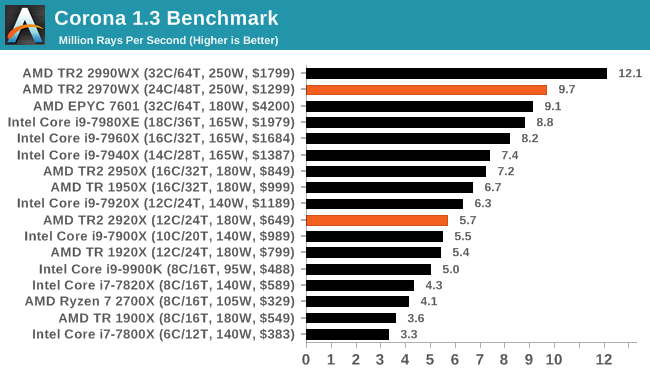
Corona scales well with cores, although memory bandwidth also helps. The 2970WX sits behind the 2990WX amd the 2920X sits behind the 2950X, as expected.
Blender 2.79b: 3D Creation Suite
A high profile rendering tool, Blender is open-source allowing for massive amounts of configurability, and is used by a number of high-profile animation studios worldwide. The organization recently released a Blender benchmark package, a couple of weeks after we had narrowed our Blender test for our new suite, however their test can take over an hour. For our results, we run one of the sub-tests in that suite through the command line - a standard ‘bmw27’ scene in CPU only mode, and measure the time to complete the render.
Blender can be downloaded at https://www.blender.org/download/
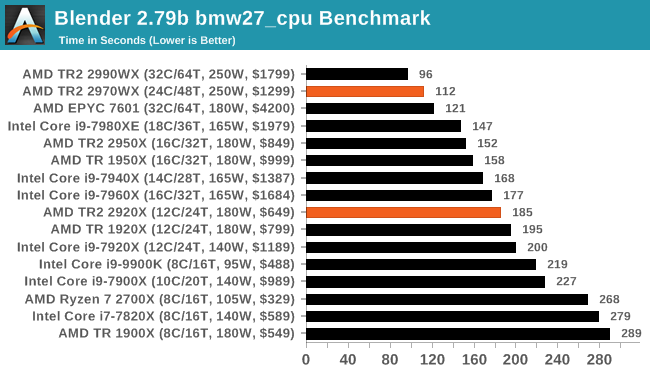
Blender is also another render that likes a mix of cores and memory, being able to put all of the the 2990WX cores to good use. The 2970WX also comes in under two minutes on this test, while the 2920X only just beats the previous generation 1920X.
LuxMark v3.1: LuxRender via Different Code Paths
As stated at the top, there are many different ways to process rendering data: CPU, GPU, Accelerator, and others. On top of that, there are many frameworks and APIs in which to program, depending on how the software will be used. LuxMark, a benchmark developed using the LuxRender engine, offers several different scenes and APIs.

Taken from the Linux Version of LuxMark
In our test, we run the simple ‘Ball’ scene on both the C++ and OpenCL code paths, but in CPU mode. This scene starts with a rough render and slowly improves the quality over two minutes, giving a final result in what is essentially an average ‘kilorays per second’.
It has been pointed out to us that LuxMark is affected by the Spectre/Meltdown patches, so consider this more of a synthetic test of different code paths.
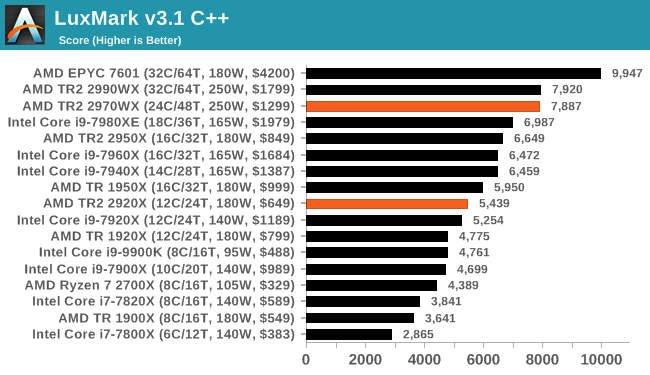
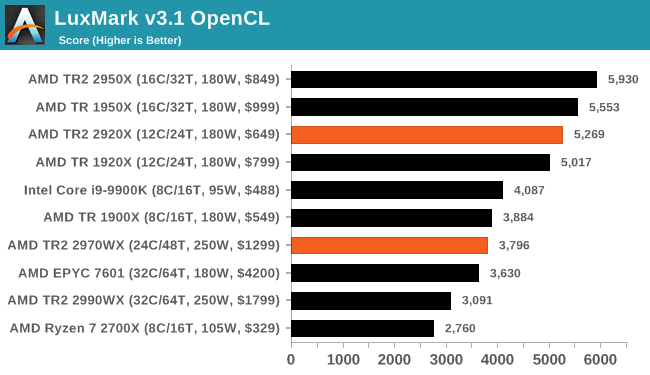
LuxMark in C++ mode seems to be able to take advantage of the extra memory bandwidht on the EPYC platform. Our Skylake-X processors never seem to be able to run the OpenCL model, but we see there are problems above 16 cores in this part of the test.
POV-Ray 3.7.1: Ray Tracing
The Persistence of Vision ray tracing engine is another well-known benchmarking tool, which was in a state of relative hibernation until AMD released its Zen processors, to which suddenly both Intel and AMD were submitting code to the main branch of the open source project. For our test, we use the built-in benchmark for all-cores, called from the command line.
POV-Ray can be downloaded from http://www.povray.org/
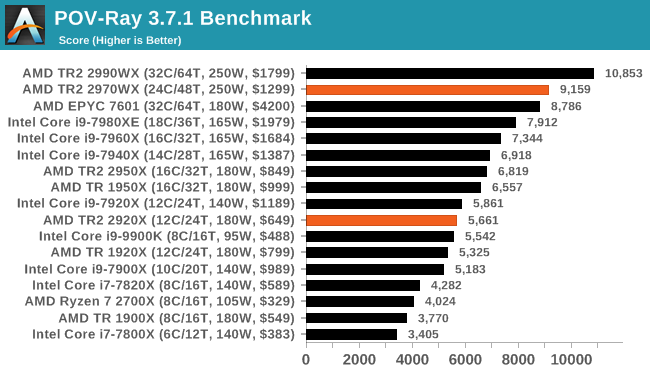


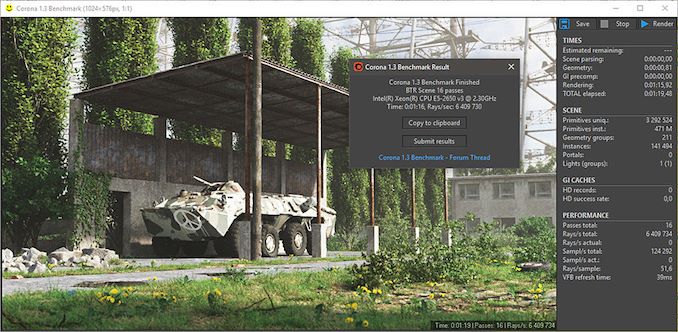








69 Comments
View All Comments
Ian Cutress - Monday, October 29, 2018 - link
EPYC 7601 is 2.2 GHz base, 3.2 GHz Turbo, at 180W, fighting against 4.2+ GHz Turbo parts at 250W. Also the memory we have to use is server ECC memory, which has worse latencies than consumer memory. I've got a few EPYC chips in, and will be testing them in due course.mapesdhs - Monday, October 29, 2018 - link
Does the server memory for EPYC run at lower clocks aswell?GreenReaper - Wednesday, October 31, 2018 - link
ECC RAM typically runs slower, yes. It's correctness that you're looking for first and foremost, and high speeds are harder to guarantee against glitches, particularly if you're trying to calculate or transfer or compare parity at the same time.iwod - Monday, October 29, 2018 - link
Waiting for Zen2Boxie - Monday, October 29, 2018 - link
only Zen2? Psshh - it was announced ages ago... /me is waiting ofr Zen5 :Pwolfemane - Monday, October 29, 2018 - link
*nods in agreement* me to, I hear good things about Zen5. Going to be epyc!5080 - Monday, October 29, 2018 - link
Why are there so many game tests with Threadripper? It should be clear by now that this CPU is not for gamers. I would rather see more tests with other professional software such as Autoform, Catia and other demanding apps.DanNeely - Monday, October 29, 2018 - link
The CPU Suite is a standard set of tests for all chips Ian tests from a lowly atom, all the way up to top end Xeon/Epyc chips; not something bespoke for each article which would limit the ability to compare results from one to the next. The limited number of "pro level" applications tested is addressed in the article at the bottom of page 4."A side note on software packages: we have had requests for tests on software such as ANSYS, or other professional grade software. The downside of testing this software is licensing and scale. Most of these companies do not particularly care about us running tests, and state it’s not part of their goals. Others, like Agisoft, are more than willing to help. If you are involved in these software packages, the best way to see us benchmark them is to reach out. We have special versions of software for some of our tests, and if we can get something that works, and relevant to the audience, then we shouldn’t have too much difficulty adding it to the suite."
TL;DR: The vendors of the software aren't interested in helping people use their stuff for benchmarks.
Ninhalem - Monday, October 29, 2018 - link
ANSYS is terrible from a licensing standpoint even though their software is very nice for FEA. COMSOL could be a much better alternative for high-end computational software. I have found the COMSOL representatives to be much more agreeable to product testing and the support lines are much better, both in responsiveness and content help.mapesdhs - Monday, October 29, 2018 - link
Indeed, ANSYS is expensive, and it's also rather unique in that it cares far more about memory capacity (and hence I expect bandwidth) than cores/frequency. Before x86 found its legs, an SGI/ANSYS user told me his ideal machine would be one good CPU and 1TB RAM, and that was almost 20 years ago.